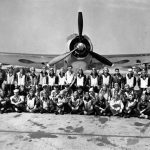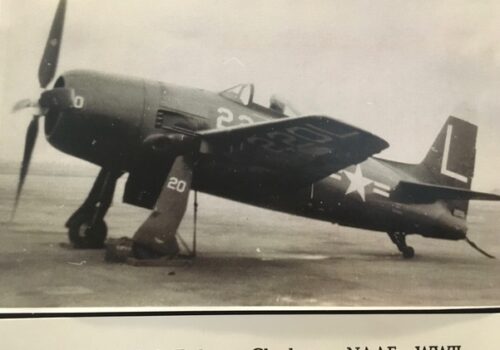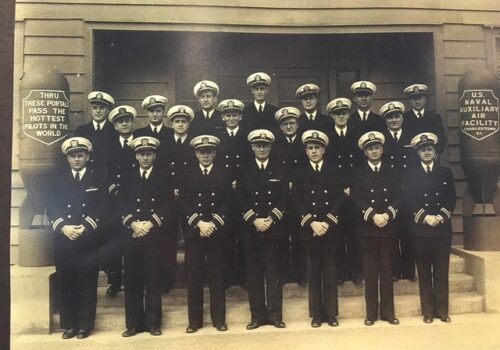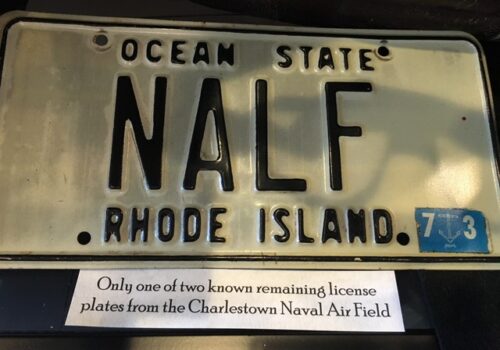In 1941, during the initial construction of the Quonset Point Complex in North Kingstown, RI, plans were made for the construction of an auxiliary air facility in Charlestown, RI, and others in the tri-state area because of the rapid mobilization and creation of a Naval Air Force which the main Quonset Point Airfield could not support.
Land taking at the Hunter’s Harbor area began in 1942, and airfield construction began in earnest early in 1943. Sufficient hangar and administrative buildings were ready by late August 1943, to permit the first spillovers from Quonset to move to Charlestown in September 1943, when aircraft training operations began. Many enlisted and officer personnel continued to use tents or barracks at Burlingame Park for lodging until the full building complex was finished in August 1945. At its completion, the AAF was redesignated as an auxiliary air station on September 1, 1945, and could accommodate 1500 officers and men.
Charlestown Naval Air Field
Visit our CNAF Display at the CHS Archive.
4417 B Old Post Road, Charlestown, RI 02813
Various torpedo and scout bomber squadrons came and went during the fall of 1943 at Charlestown; and Air Group 51 trained here with its Hellcats and Avengers for two months until it embarked on its combat tour in the Pacific in January 1944 aboard the USS San Jacinto.
In early 1944, the crowding at Quonset Point forced the movement of the night fighter training unit (NFTU) from Quonset to Charlestown where it was recognized and rapidly expanded. Soon NFTU was using airfields at Westerly, Hyannis and Martha’s Vineyard and had its ‘Mickey’ Radar Control Unit based at the South end of Conanicut Island, Jamestown, RI.
NFTU, later to become Night Air Combat Training Unit Atlantic (NACTULANT) was the practical result of Project Affirm, which introduced radar to US carrier aircraft, trained pilots, fighter pilots, fighter directors and maintenance personnel and evolved tactical doctrines. Charlestown was the principle station, others followed.
A night training unit was begun at Charlestown but moved to Quonset and Sanford, Maine in 1944. The special young men sent here were trained their senses and basic instincts and to rely totally on their instruments.
Pilots assigned to Charlestown had about 500 hours total flight time; their instructors had over 1,000 total hours. The training syllabus lasted about four months and consisted of tactics, gunnery, carrier landings, navigation and instrument flying during daylight and at night. NAAS Charlestown had a wooden carrier deck constructed adjacent to RW-22 for catapult training.
Night Fighters lived “on the back side of the clock”, training every available hour in all weather. Pilots learned to identify aircraft and ships, to navigate and to operate completely under night conditions very similar to those to be encountered off the shores of Japan. Split second responses to cockpit display and ground control ended each exercise with the gratifying report: “Splash”. If not, repeat and repeat.
But real losses occurred in the cold nights off the coasts of Southern New England and in the woods and swamps of Charlestown. Some wreck sites still remain as evidence of the sacrifice of these young men.
Later, dedicated night Air Groups were trained as cohesive units and deployed as units on aircraft carriers dedicated to Night Air Combat. Such units as Air Group 41, 52 and 55 began their existence at Charlestown. From Charlietown to Hawaii, and onto the Carriers Independence, Bon Homme Richard, Saratoga, Enterprise, Hornet and Franklin went the men trained at Charlestown.
At war’s end, great reductions in Naval Aviation forced the closing of all but Quonset Point and Charlestown. Once the confused situation had sorted out by late 1946, two full Air Groups were based at Charlestown until its reduction in status in late 1949.
The Korean conflict and the resurgence of the Naval Air Arm forced the reopening of the redesignated Naval Auxiliary Landing Field at Charlestown in 1951 for use as a practice carrier landing field. There were never more than 150 personnel on the airfield and no aircraft were based there until its closing in 1974 when NAS Quonset Point was closed.









